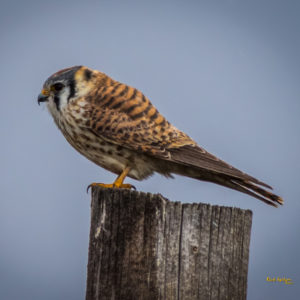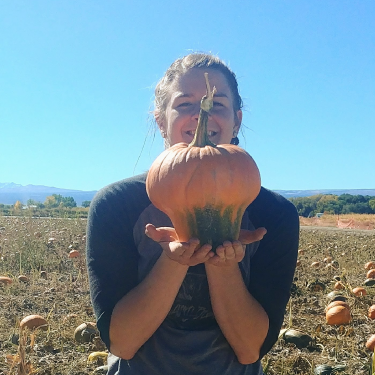 Perhaps you were stuck in construction traffic on I70, or maybe you were taking it easy on Highway 6, absentmindedly scanning the road and the scenery. Suddenly, you see a flash of color out of the corner of your eye and glance over to see a colorful bird land on a nearby fence post. If this experience sounds familiar to you, you may have gotten the chance to glimpse North America’s smallest falcon, the American kestrel.
Perhaps you were stuck in construction traffic on I70, or maybe you were taking it easy on Highway 6, absentmindedly scanning the road and the scenery. Suddenly, you see a flash of color out of the corner of your eye and glance over to see a colorful bird land on a nearby fence post. If this experience sounds familiar to you, you may have gotten the chance to glimpse North America’s smallest falcon, the American kestrel.
About as large as a pigeon, the kestrel is unremarkable in size. Therefore, these falcons are more easily identified by their colorful plumage. Male kestrels have slate blue feathers on their heads and wings contrasting beautifully with the warm red on their back and tail feathers. While most female birds are less colorful than males, the female kestrel shares the warm red color and barred back of the male. Both genders have black slashes down the sides of their faces, creating a side-burn look that would make even Elvis jealous.
Small but mighty, the kestrel is a ferocious predator despite its small stature (if you’re about the size of a grasshopper, that is). The American kestrel typically hunts insects such as cicadas, beetles, dragonflies, grasshoppers, butterflies, and moths. When they catch anything larger, like voles, shrews, bats, or small songbirds, they have to seek out a hiding place for their leftovers in grass clumps, tree roots, or small shrubs. Losing their lunch isn't the biggest of a kestrel’s worries though, as being a small falcon makes it fair game for larger birds of prey, snakes, and even fire ants.
Life isn’t all eat or be eaten for kestrels, though. These birds have a complex system when it comes to finding a mate and starting a family. To even be considered eligible, the male must first claim a territory that has several options for nesting cavities. Kestrels don’t build nests, so they will find a natural hollow in a tree, an old woodpecker hole, or even a nook within a man-made building to nest in. Once he’s established his territory, the male will start his courtship dance, flying up and calling out to any nearby ladies that may be listening and then swooping back down, advertising his territory.
Once he’s caught the eye of a female, the male kestrel will show her all of his nesting options and she makes the final decision on the place they will call home. The female typically lays four to five eggs, and after approximately 30 days, the young birds hatch to join the family. Since the nestlings cannot leave the nest when nature calls, housekeeping becomes quite an issue. To keep things tidy, the hatchlings will aim their feces for the sides of the nest, allowing it to dry outside the living space and keeping the hatchlings clean.
If you’re hoping to spot a kestrel in the valley, head down valley to Eagle or Gypsum and keep a close eye on telephone poles, fence posts, and utility lines where the kestrels may be on the lookout for their next meal. Additionally, kestrels take well to nest boxes as nesting cavities, so putting one up around mid-spring could attract a mating pair to your own backyard. These flashy falcons are worth a second look, so providing a space for them to stick around would add some beautiful color to your backyard scenery!
Haley Baker is a Naturalist and Sustainability Intern at Walking Mountains Science Center. While she’s always believed the Peregrine Falcon is the coolest raptor on Earth, she will concede the American kestrel is a close second.









